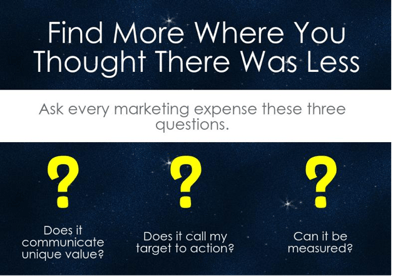 It’s February. Need I say more?
It’s February. Need I say more?
All those New Year’s marketing resolutions have gone by the wayside and the reality of a limited budget has hit home. Marketing Directors everywhere are wishing that their 2016 Marketing budget was bigger. More money invested in Marketing means better results… or so the thinking goes.
There are times when increased Marketing investment is necessary, but that’s not always the case.
Getting better results might not be about how much you spend, but how you think about Marketing.
If you’ve started 2016 with a Marketing budget you’re not excited about, focus on these three important strategy basics. With every Marketing expense, ask yourself these questions. As you do, you may find that your current budget already contains the additional resources you need.
Question #1 – Does It Communicate a Unique Value Proposition?
When faced with a limited budget, it’s necessary to focus your thinking on the specific reasons why your target customers should choose your product or service over your competitors. Peter Sandeen defines the Unique Value Proposition as the “believable collection of reasons your target customers should do what you’re hoping they will do.” This is a great summary of this important concept. With every Marketing initiative you undertake this year, ask yourself if you can clearly and consistently communicate your UVP. If not, this may be an expenditure you could do without.
Question #2 – Does it Focus My Target on a Call To Action?
With a limited budget, every marketing investment must contribute to results. Often, however, marketers fail to tell their target how to take the next step. A call-to-action (CTA) could be anything from subscribing to a newsletter to calling a sales agent directly, but make sure that every communication includes at least one. If a marketing investment does not lend itself to call-to-action, ask yourself if there’s really room for it in your budget. Crazyegg shares some great CTA examples here.
Question #3 - Can it Be Measured?
With limited marketing dollars, there’s no room for investments that can’t prove their value. Yet, many tactics produce little data on how well they contribute to results. While you may expect different results from different initiatives, make sure that you examine each to determine just how its success will be measured. If it can’t be measured, take a hard look at its place in your budget. Looking for what to measure? Start with Question #2, above. For more ideas on Marketing measurement, check out this blog post from McKinsey and Company
In closing, try this important exercise. Right now, before the New Year gets away from you, sit down with your 2015 marketing budget. Go over every line item and ask it to answer “Yes” to each of these three questions. For those that can’t, write it’s allocated budget on a sheet of paper and total the column. How much of your total budget does that represent – five percent? Fifteen percent? More? How does this total compare to the budget increase were you hoping for this year? Does this provide some insight into where you might look for those “additional” dollars you need?
As you progress through the year, keep holding your marketing investments accountable. We at Rezora will be doing the same.
Links to Additional Resources:
http://www.petersandeen.com/what-is-your-value-proposition/
http://blog.crazyegg.com/2013/07/24/call-to-action-examples/
http://www.mckinsey.com/insights/marketing_sales/measuring_marketings_worth



